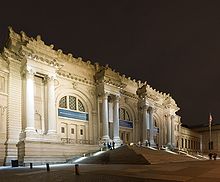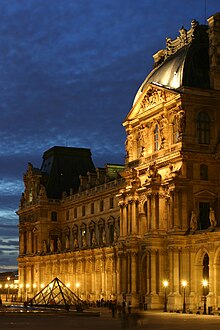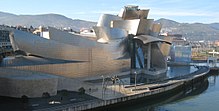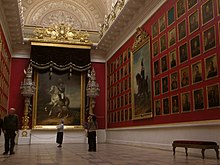This is an old revision of this page, as edited by 64.22.211.42 (talk) at 16:48, 3 April 2009 (→Notable art museums). The present address (URL) is a permanent link to this revision, which may differ significantly from the current revision.
Revision as of 16:48, 3 April 2009 by 64.22.211.42 (talk) (→Notable art museums)(diff) ← Previous revision | Latest revision (diff) | Newer revision → (diff)| This article needs additional citations for verification. Please help improve this article by adding citations to reliable sources. Unsourced material may be challenged and removed. Find sources: "Art museum" – news · newspapers · books · scholar · JSTOR (January 2007) (Learn how and when to remove this message) |




An art gallery or art museum is a space for the exhibition of art, usually visual art. Paintings are the most commonly displayed art objects; however, sculpture, photographs, illustrations, installation art and objects from the applied arts may also be shown. Although primarily concerned with providing a space to show works of visual art, art galleries are sometimes used to host other artistic activities, such as music concerts or poetry readings.
Types of galleries
The term is used for both public galleries, which are museums for the display of selected collection of art. On the other hand private galleries refers to the commercial enterprises for the sale of art. However, both types of gallery may host temporary exhibitions including art borrowed from elsewhere.
Galleries in Museums
The rooms in museums where art is displayed for the public are often referred to as galleries as well, with a room dedicated to Ancient Egyptian art often being called the Egypt Gallery, for example.
Contemporary Art Gallery
Main article: Contemporary art galleryThe term contemporary art gallery refers usually to a privately owned for-profit commercial gallery. These galleries are often found clustered together in large urban centers. The Chelsea district of New York City, for example, is widely considered to be the center of the contemporary art world. Even small may be home to at least one gallery, but they may also be found in small communities, and remote areas where artists congregate, i.e. the Taos art colony and St Ives, Cornwall.
Contemporary art galleries are usually open to the general public without charge; however, some are semi-private. They usually profit by taking a cut of the art's sales; from 25 to 50% is usual. There are also many not-for-profit and art-collective galleries. Some galleries in cities like Tokyo charge the artists a flat rate per day, though this is considered distasteful in some international art markets. Galleries often hang solo shows. Curators often create group shows that say something about a certain theme, trend in art, or group of associated artists. Galleries sometimes choose to represent artists exclusively, giving them the opportunity to show regularly.
A gallery's definition can also include the artist run centre, which often (in North America and Western Europe) operates as a space with a more democratic selection and mentality. An artist-run space also typically has a board of directors and a support staff that select and curate shows by committee, or some kind of similar process to choose art that typically lacks commercial ends.
Online galleries
With the emergence of the internet many artists and gallery owners have opened art galleries online.
- International Art Gallery - www.internationalartgallery.org - Airbrush, Ceramics And Glass, Paintings, Photography, Sculptures, Tapestries, Tattoo...
Vanity galleries
Main article: Vanity galleryA vanity gallery is an art gallery that charges fees from artists in order to show their work, much like a vanity press does for authors. The shows are not legitimately curated and will frequently or usually include as many artists as possible. Most art professionals are able to identify them on an artist's resume.
Visual art not shown in a gallery
Works on paper, such as drawings and old master prints are usually not chosen by curators to be permanently displayed for conservation reasons. Instead, any collection is held in a print room in the museum. Murals generally remain where they have been painted, although many have been removed to galleries. Various forms of 20th century art, such as land art and performance art, also usually exist outside a gallery. Photographic records of these kinds of art are often shown in galleries, however. Most museum and large art galleries own more works than they have room to display. The rest are held in reserve collections, on or off-site.
Similar to an art gallery is the sculpture garden (or sculpture park), which presents sculpture in an outdoor space. Sculpture installation has grown in popularity, whereby temporary sculptures are installed in open spaces during events like festivals.
Architecture


The architectural form of the art gallery was established by Sir John Soane with his design for the Dulwich Picture Gallery in 1817. This established the gallery as a series of interconnected rooms with largely uninterrupted wall spaces for hanging pictures and indirect lighting from skylights or roof lanterns.
The late 19th century saw a boom in the building of public art galleries in Europe and America, becoming an essential cultural feature of larger cities. More art galleries rose up alongside museums and public libraries as part of the municipal drive for literacy and public education.
In the late 20th century the dry old-fashioned view of art galleries was increasingly replaced with architecturally bold modern art galleries, often seen as international destinations for tourists. The first example of the architectural landmark art gallery would be the Guggenheim Museum in New York City by Frank Lloyd Wright. More recent examples include Frank Gehry's Guggenheim Museum Bilbao and Mario Botta redesign of San Francisco Museum of Modern Art. Some critics argue that these galleries are self-defeating, in that their dramatic interior spaces distract the eye from the paintings they are supposed to exhibit.
Notable art museums










Africa
- Cairo: Egyptian Museum, Museum of Islamic Art
- Cape Town: South African National Gallery
- Harare: National Gallery of Zimbabwe
- Johannesburg: MuseuMAfricA, Johannesburg Art Gallery
Asia
- Baghdad: National Museum of Iraq
- Beijing: Palace Museum
- Dhaka: Zainul Gallery
- Hong Kong: Hong Kong Museum of Art
- Jakarta: Indonesian National Gallery
- New Delhi: National Gallery of Modern Art, National Museum
- Shanghai: Shanghai Museum
- Taipei: National Palace Museum
- Tokyo: Tokyo National Museum
- Ooty: Wax World Museum & Art Gallery
- Goa: Wax World Museum & Art Gallery
- National Art Gallery, Islamabad
Europe
- Amsterdam: Rijksmuseum, van Gogh Museum
- Athens: National Archaeological Museum of Athens, New Acropolis Museum
- Barcelona: Museu Nacional d'Art de Catalunya, Museu Picasso
- Barnard Castle: Bowes Museum
- Bath: Holburne Museum of Art
- Berlin: Museum Island, Gemäldegalerie, Berlin, Neue Nationalgalerie
- Bilbao: Guggenheim Museum
- Birmingham: Birmingham Museum & Art Gallery, Barber Institute of Fine Arts
- Bristol (UK): Royal West of England Academy, Bristol City Museum and Art Gallery
- Brussels: Royal Museums of Fine Arts of Belgium
- Bucharest: National Museum of Art of Romania, The Art Collectins Museum, K.H. Zambaccian Museum, Theodor Pallady Museum
- Budapest: Museum of Fine Arts, Museum of Applied Arts
- Cambridge (UK): Fitzwilliam Museum, Kettle's Yard
- Cardiff: National Museum
- Colmar: Unterlinden Museum
- Copenhagen: Ny Carlsberg Glyptotek, Arken Museum of Modern Art, Statens Museum for Kunst, Thorvaldsens Museum
- Dresden: Gemäldegalerie Alte Meister
- Dublin: Hugh Lane Municipal Gallery, Irish Museum of Modern Art, National Gallery of Ireland,
- Edinburgh: National Gallery of Scotland, Scottish National Gallery of Modern Art, Dean Gallery, Scottish National Portrait Gallery
- Florence: Galleria degli Uffizi, Accademia di Belle Arti Firenze, Palazzo Pitti, Bargello, La Specola, Museo di Storia Naturale di Firenze, Institute and Museum of the History of Science
- Frankfurt: Städelsches Kunstinstitut and Städtische Galerie
- Glasgow: Gallery of Modern Art, Kelvingrove Art Gallery and Museum, Burrell Collection, Hunterian Art Gallery
- Helsinki: Ateneum Art Museum, Museum of Contemporary Art Kiasma
- Istanbul: Istanbul Archaeology Museum, Pera Museum, Sakıp Sabancı Museum, Great Palace Mosaic Museum, Topkapı Palace, Turkish and Islamic Arts Museum
- Kyiv: Museum of Western and Oriental Art
- Leeds: The Royal Armouries Museum, Temple Newsam, Leeds Art Gallery
- Lisbon: Museu Nacional de Arte Antiga, Museu Calouste Gulbenkian
- Liverpool: Walker Art Gallery, Tate Liverpool, Sudley House
- London: National Gallery, National Portrait Gallery, Tate Britain, Tate Modern, Victoria and Albert Museum, British Museum, Dulwich Picture Gallery, Saatchi Gallery, Courtauld Gallery, Queen's Gallery, Gilbert Collection, Sir John Soane's Museum, Kenwood House, Wallace Collection, Apsley House, Foundling Museum, Guildhall Art Gallery, Leighton House Museum, Dalí Universe, Percival David Foundation of Chinese Art, Ranger's House (Wernher Collection), Hermitage Rooms, The Hayward
- Madrid: Museo del Prado, Museo Reina Sofia, Museo Thyssen Bornemisza
- Manchester: Manchester Art Gallery
- Milan: Castello Sforzesco, Pinacoteca di Brera, Biblioteca Ambrosiana, Museo Poldi Pezzoli
- Moscow: State Tretyakov Gallery, Pushkin Museum, Kremlin Armoury, Moscow Museum of Modern Art, Moscow House of Photography, State Historical Museum
- Munich: Alte Pinakothek, Neue Pinakothek, Pinakothek der Moderne
- Naples: Museo di Capodimonte, Naples National Archaeological Museum, Caserta Palace
- Oslo: National Gallery of Norway
- Oxford: Ashmolean Museum, Christ Church Picture Gallery
- Paris: Musée du Louvre, Musée d'Orsay, Musée Rodin, Centre Pompidou, Musée Picasso, Guimet Museum, Musée Marmottan Monet, Musée de Cluny, Musée de l'Orangerie, Musée des Arts Décoratifs, Musée Jacquemart-André
- Possagno: The Canova Museum
- Prague: National Gallery, Náprstek Museum, Rudolfinum Gallery
- Rome: Vatican Museum, Galleria Borghese, National Museum of Rome, Palazzo Barberini, Capitoline Museums, National Etruscan Museum, Doria Pamphilj Gallery, Museum of Roman Civilization
- Roubaix: La Piscine
- Saratov: Radischev Art Museum
- St Ives: Tate St Ives
- St. Petersburg: Hermitage, Russian Museum
- Stockholm: Nationalmuseum
- Strasbourg: Musée de l’Œuvre Notre-Dame, Musée des Beaux-Arts, Musée d'art moderne et contemporain, Musée des Arts décoratifs
- Stuttgart: Staatsgalerie
- Syracuse, Sicily: Archaeological Museum
- Taganrog: Taganrog Museum of Art
- Thun: Kunstmuseum Thun
- Turin: Museo Egizio, Museum of Ancient Art, Turin Museum of Natural History
- Venice: Accademia, Peggy Guggenheim Collection, Ca' Rezzonico, Ca' d'Oro, Ca' Pesaro
- Vienna: Kunsthistorisches Museum, Leopold Museum, Albertina, Österreichische Galerie Belvedere, MUMOK, Liechtenstein Museum
- Vaduz: Kunstmuseum Liechtenstein
- Warsaw: Centre for Contemporary Art, National Gallery
- Zürich: Foundation E.G. Bührle
North America
- Atlanta, Georgia: Michael C. Carlos Museum, High Museum of Art
- Baltimore, Maryland: Baltimore Museum of Art, Walters Art Museum
- Baton Rouge, Louisiana: Shaw Center for the Arts
- Birmingham, Alabama: Birmingham Museum of Art
- Boston, Massachusetts: Boston Museum of Fine Arts, Isabella Stewart Gardner Museum
- Brunswick, Maine: Bowdoin College Museum of Art
- Buffalo, New York: Albright-Knox Art Gallery
- Cambridge, Massachusetts: Harvard Art Museums
- Charleston, South Carolina: Gibbes Museum of Art
- Charlotte, North Carolina: Mint Museum of Art
- Chadds Ford, Pennsylvania: Brandywine River Museum
- Chicago: Art Institute of Chicago, Museum of Contemporary Art, Oriental Institute, Terra Museum
- Cincinnati, Ohio: Cincinnati Art Museum
- Cleveland, Ohio: The Cleveland Museum of Art
- Columbia, South Carolina: Columbia Museum of Art
- Columbus, Ohio: Columbus Museum of Art, Wexner Center
- Cooperstown, New York: Fenimore Art Museum
- Dallas, Texas: Dallas Museum of Art, Meadows Museum
- Davenport, Iowa: Figge Art Museum
- Denver, Colorado: Denver Art Museum
- Des Moines, Iowa: Des Moines Art Center
- Detroit, Michigan: The Detroit Institute of Arts, Cranbrook Art Museum, University of Michigan-Museum of Art
- Edmonton, Alberta: Art Gallery of Alberta
- Fort Worth, Texas: Amon Carter Museum, Kimbell Art Museum
- Glens Falls, New York: Hyde Collection
- Grand Rapids, Michigan: Grand Rapids Art Museum
- Greensboro, North Carolina: Weatherspoon Art Museum
- Greenville, Delaware: Henry Francis DuPont Winterthur Museum
- Halifax, Nova Scotia: Art Gallery of Nova Scotia
- Hanover, New Hampshire: Hood Museum of Art
- Hartford, Connecticut: Wadsworth Atheneum
- Houston, Texas: Museum of Fine Arts, Houston, Menil Collection
- Honolulu: Honolulu Academy of Arts
- Indianapolis, Indiana: Indianapolis Museum of Art
- Jackson Hole, Wyoming: National Museum of Wildlife Art
- Jacksonville, Florida: Museum of Contemporary Art Jacksonville
- Kansas City, Missouri: Nelson-Atkins Museum of Art, Kemper Museum of Contemporary Art
- Little Rock, Arkansas: Arkansas Arts Center
- Lower Merion, Pennsylvania: Barnes Foundation
- Los Angeles, California: J. Paul Getty Museum, Los Angeles County Museum of Art
- Louisville, Kentucky: Speed Art Museum
- Manchester, New Hampshire: Currier Museum of Art
- Memphis, Tennessee: Dixon Gallery and Gardens, Memphis Brooks Museum of Art
- Mexico City, Mexico: Palacio de Bellas Artes
- Miami, Florida: Bass Museum, Frost Art Museum, Lowe Art Museum, Miami Art Museum, Museum of Contemporary Art, Wolfsonian-FIU Museum
- Milwaukee, Wisconsin: Milwaukee Art Museum
- Minneapolis, Minnesota: Minneapolis Institute of Arts, Walker Art Center, Weisman Art Museum
- Monterrey, Mexico: Museo de Arte Contemporáneo, Museo del Palacio de Gobierno de Nuevo Leon
- Montgomery, Alabama: Montgomery Museum of Fine Arts
- Montreal, Quebec: Montreal Museum of Fine Arts
- New Britain, Connecticut: New Britain Museum of American Art
- New Haven, Connecticut: Yale Center for British Art, Yale University Art Gallery
- New Orleans, Louisiana: Ogden Museum of Southern Art, New Orleans Museum of Art
- New York City: Guggenheim, Metropolitan Museum of Art, Museum of Modern Art (MoMA), Whitney Museum of American Art, Brooklyn Museum, Frick Museum, The Morgan Library & Museum, The Cloisters, Dahesh Museum, Asia Society, Neue Galerie, Hispanic Society of America, Museum of the City of New York, Cooper-Hewitt Museum, New Museum of Contemporary Art, Rubin Museum of Art, P.S.1 Contemporary Art Center, Jacques Marchais Museum of Tibetan Art
- North Adams, Massachusetts: Massachusetts Museum of Contemporary Art
- Norfolk, Virginia: Chrysler Museum of Art
- Oberlin, Ohio: Allen Memorial Art Museum
- Omaha, Nebraska: Joslyn Art Museum
- Ottawa, Ontario: National Gallery of Canada
- Pasadena, California: Norton Simon Museum
- Philadelphia: Philadelphia Museum of Art, Rodin Museum
- Phoenix, Arizona: Phoenix Art Museum
- Pittsburgh, Pennsylvania: Carnegie Museum of Art, Andy Warhol Museum
- Ponce, Puerto Rico: Ponce Museum of Art
- Portland, Oregon: Portland Art Museum
- Princeton, New Jersey: Princeton University Art Museum
- Providence, Rhode Island: Rhode Island School of Design Museum
- Raleigh, North Carolina: North Carolina Museum of Art
- Richmond, Virginia: Virginia Museum of Fine Arts
- Rockland, Maine: Farnsworth Art Museum
- Salem, Massachusetts: Peabody Essex Museum
- San Antonio, Texas: Artpace, Blue Star Contemporary Art Center, McNay Art Museum, San Antonio Museum of Art
- San Francisco, California: San Francisco Museum of Modern Art, California Palace of the Legion of Honor, M. H. de Young Memorial Museum
- San Marino, California: Huntington Library, Art Collections and Botanical Gardens
- Sarasota, Florida: Ringling Museum of Art
- Savannah, Georgia: Telfair Museum of Art
- Seattle, Washington: Seattle Art Museum
- Shelburne, Vermont: Shelburne Museum
- St. Louis, Missouri: Saint Louis Art Museum
- Toronto, Ontario: Art Gallery of Ontario
- Toledo, Ohio: Toledo Museum of Art
- Vancouver, British Columbia: Vancouver Art Gallery, Morris and Helen Belkin Art Gallery
- Washington, D.C.: National Gallery of Art, Hirshhorn Museum and Sculpture Garden, National Museum of Women in the Arts, Phillips Collection, Dumbarton Oaks, Smithsonian American Art Museum, Corcoran Gallery of Art, National Portrait Gallery
- West Palm Beach, Florida: Norton Museum of Art
- Williamstown, Massachusetts: Clark Art Institute, Williams College Museum of Art
- Wilmington, Delaware: Delaware Art Museum, Delaware Center for the Contemporary Arts
- Winnipeg, Manitoba: Winnipeg Art Gallery
- Worcester, Massachusetts: Worcester Art Museum
Oceania
- Brisbane: Queensland Art Gallery (QAG) and the Gallery of Modern Art (GoMA)
- Canberra: National Gallery of Australia
- Mangaweka : Permanent display of New Zealands most famed forger C.F. Goldie (aka Karl Sim)
- Melbourne: National Gallery of Victoria
- Nelson: world of wearable art Museum
- Sydney: Art Gallery of New South Wales
- Wellington: Museum of New Zealand Te Papa Tongarewa
Latin America
- Buenos Aires: Museo Nacional de Bellas Artes
- Havana: Museo Nacional de Bellas Artes
- Lima: Museo de Arte de Lima
- Mexico City: Palacio de Bellas Artes
- Rio de Janeiro: Museu Nacional de Belas Artes
- Santiago de Chile: Museo Nacional de Bellas Artes
- São Paulo: São Paulo Museum of Art
List of notable contemporary galleries

- Bombay: The Arts Trust - Institute of Contemporary Indian Art
- Delhi: Art Alive Gallery - Contemporary Indian Art Gallery
- Lausanne, Switzerland: Lucy Mackintosh Gallery
- London: Saatchi Gallery Victoria Miro Gallery Alwin Gallery
- Los Angeles: Paragon Fine Art
- Madrid: Museo de Arte Contemporáneo Thyssen-Bornemisza Museum
- Mexico City: Galería OMR
- Miami: Art Basel Miami Beach, Romero Britto Gallery, Virgina Miller Galleries
- Minneapolis: Walker Art Center
- New York: Bodley Gallery Gagosian Gallery Park Place Gallery Zach Feuer Gallery
- Paris: Daniel Templon Emmanuel Perrotin Yvon Lambert
- São Paulo: Museum of Contemporary Art
- Sedona: Exposures International Gallery of Fine Art
- Tampa: Contemporary Art Museum
- Tehran: Tehran Museum of Contemporary Art
- Tel Aviv: Raw Art Gallery
- Tokyo: Itsutsuji Gallery
- Toronto: Peak Gallery
- Valencia : Institut Valencià d'Art Modern (IVAM)
- Waterloo, Canada: The Canadian Clay and Glass Gallery
Online gallery
- International Art Gallery - www.internationalartgallery.org - Airbrush, Ceramics And Glass, Paintings, Photography, Sculptures, Tapestries, Tattoo...
See also
- Art exhibition
- Artist-run initiative
- Artist-run space
- Arts centre
- Contemporary art gallery
- List of notable museums and galleries
- National gallery
- Vanity gallery
References
- wiktionary:art gallery
- NYFA.org: 'Investing in Your Career, A Worth While Risk?'
- Dulwich Picture Gallery#History of the building